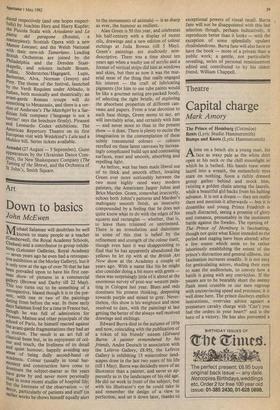Art
t)own to basics
John McEwen
Michael Salaman will doubtless be well known to many people as a teacher (Camberwell, the Royal Academy Schools, Chelsea) and a contributor to group exhibi- tions (Leicester Galleries, Royal Academy seven years ago he even had a retrospec- !lye exhibition at the Morley Gallery), but it is only now at the age of over 70 that he has been prevailed upon to have his first one- man show of pictures in a commercial eery (Browse and Darby till 22 May). s too turns out to be something of a retrospective, biased though it is to the pre- sent, with one or two of the paintings dating from before the war. In those early days Salaman lived for a time in France but, though he was full of admiration for Picasso, Matisse and other principals of the school of Paris, he himself reacted against the avant-garde fragmentations they had set In motion. The result is an art full of classical bone but, in its enjoyment of col- °or and touch, the liveliness of its detail and quiet humour, happily avoiding any sense of being dully second-hand or academic. Colour (usually in tonal har- 1,111°111es) and construction have come to donate the subject-matter as the years have gone by and never more personally t'ta :1411 in some recent studies of hospital life; but the keenness of the observation — of decor, particularly of patients and staff (in earlier works he shows himself equally alert to the movements of animals) — is as sharp as ever, the humour as resilient.
Alan Green is 50 this year, and celebrates his half-century with a display of recent oils, drawings and a new edition of colour etchings at Juda Rowan (till 5 May). Green's paintings are studiously non- descriptive. There was a time about ten years ago when a washy use of acrylic and a format of vertical strips did hint at windows and skies, but then as now it was the mat- erial meat of the thing that really engaged his interest — the craft of lubricating pigments (for him to use tube paints would be like a gourmet eating pre-packed food), of selecting the right bristle, of exploring the absorbent properties of different can- vases and papers. From a true devotion to such base things, Green seems to say, art will inevitably arise, and certainly with him — and never more so than in the present show — it does. There is plenty to excite the imagination in the contemplation of these subtly transmuted colours — colours rarefied on these latest canvases by increas- ingly complicated build ups and contrasting surfaces, matt and smooth, absorbing and repelling light.
As before, wax has been made liberal use of to thick and smooth effect, locating Green ever more noticeably between the two most highly rated waxy modern painters, the Americans Jasper Johns and Brice Marden. Green, somewhat insecurely, echoes both Johns's patterns and Marden's mahogany smooth finish, an insecurity compounded by a feeling that he does not • quite know what to do with the edges of his squares and rectangles — whether, that is, to leave them trimmed or untrimmed. There is an irresolution and daintiness in some of this that is belied by the refinement and strength of the colour itself, though even here it was disappointing to find that he has apparently abandoned the yellows he let rip with at the British Art Now show at the Academy a couple of years ago. With a name like his he might also consider doing a bit more with green there was surprisingly little of it about at the enormous survey of post-war western pain- ting in Cologne last year. Blues and reds dominate his present thinking, deepening towards purple and mixed to grey. Never- theless, this show is his weightiest and most resolved to date, with the paintings at last getting the better of the always well received drawings and etchings.
Edward Burra died in the autumn of 1976 and now, coinciding with the publication of a token of his friends' esteem (Edward Burra: A painter remembered by his friends, Andre Deutsch in association with the Lefevre Gallery, £8.95), the Lefevre Gallery is exhibiting 13 watercolour land- scapes done in the last two years of his life (till I May). Burra was decidedly more of an illustrator than a painter, and never so ap- parently as in the landscapes of his old age. He did no work in front of the subject, but with his illustrator's eye he could take in and remember the design of a view to perfection, and set it down later, thanks to exceptional powers of visual recall. Burra fans will not be disappointed with this last selection though, perhaps indicatively, it reproduces better than it looks — with the exception of some splendidly opulent rhododendrons. Burra fans will also have to have the book — more of a private than a public work; a gentle, not particularly revealing, series of personal reminiscences edited and contributed to by his oldest friend, William Chappell.






































 Previous page
Previous page